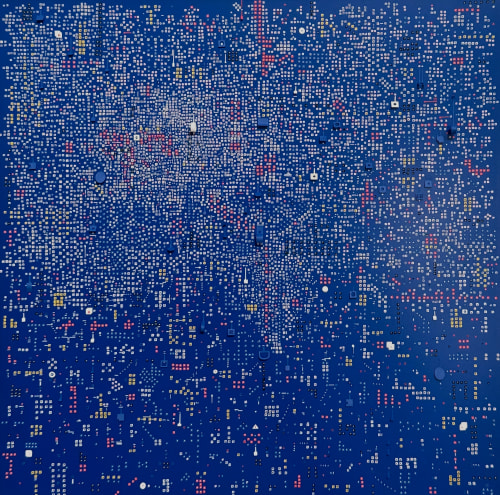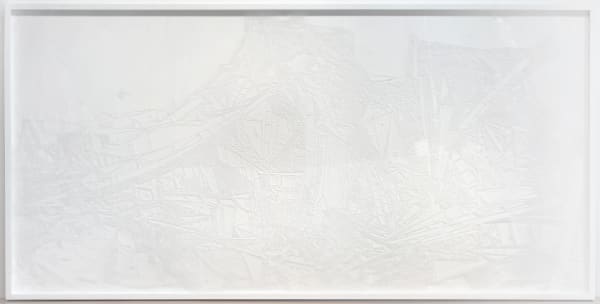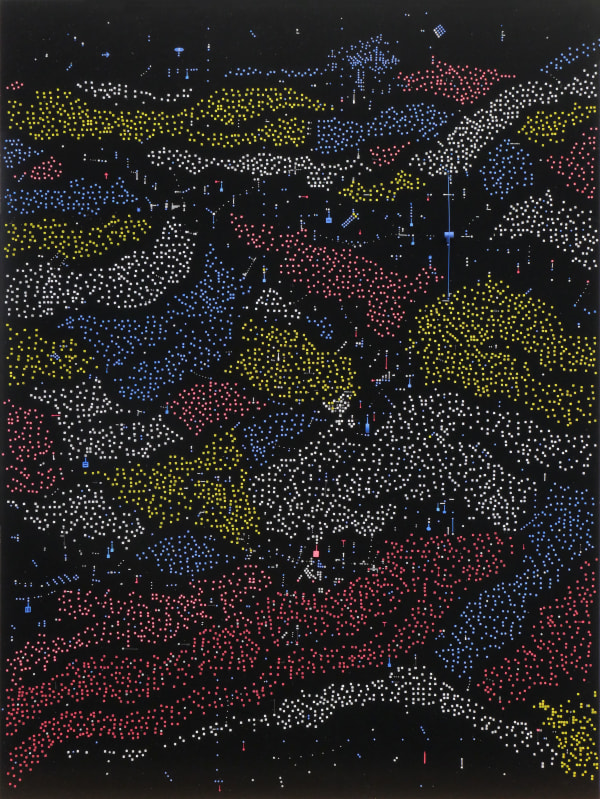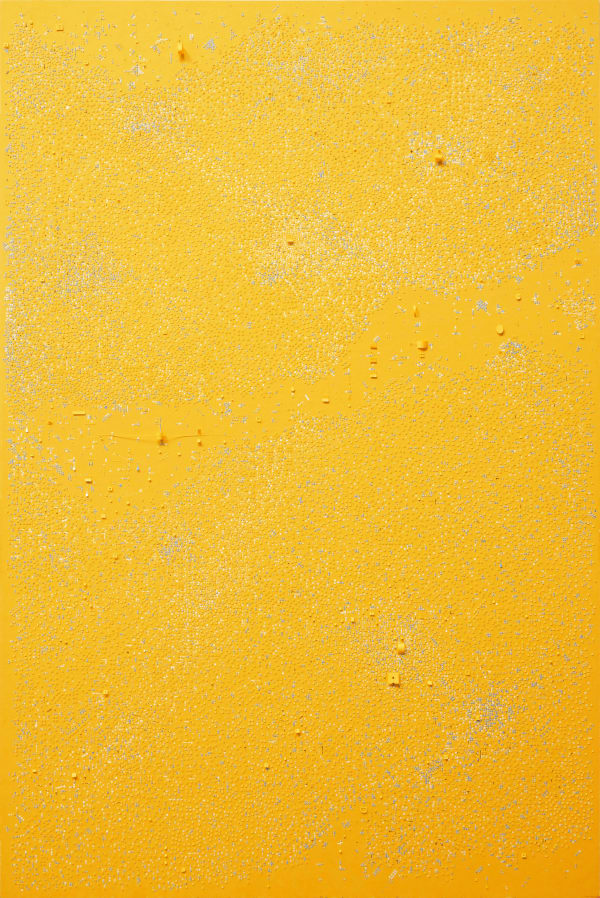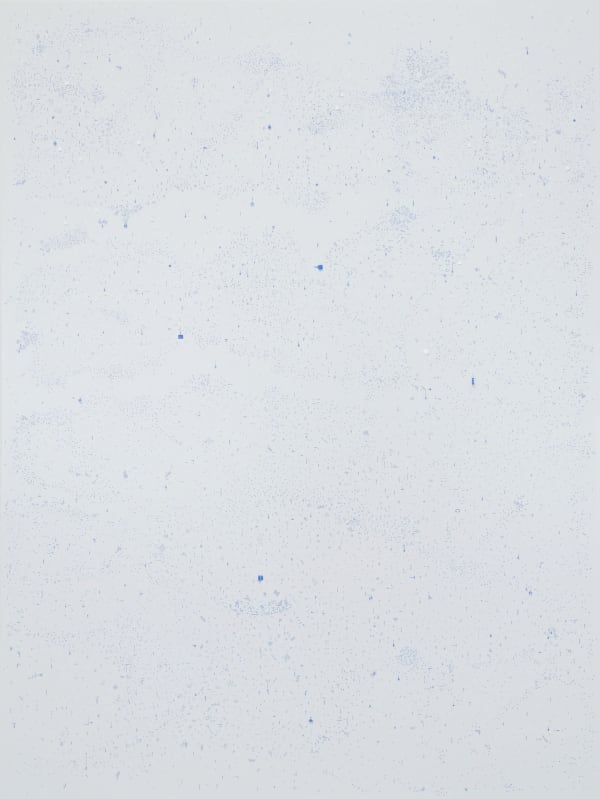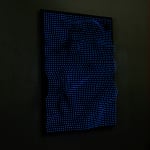JIM CAMPBELL & MARCO MAGGI : ALMOST INDECIPHERABLE
In two solo exhibitions and one collaborative piece, two artists with very different practices - Uruguayan post-minimalist, Marco Maggi, and Bay Area tech pioneer, Jim Campbell - explore perception and how a viewer's perspective informs their interpretation of an artwork or experience. One artist's primary tools are paper, an X-ACTO knife and graphite, while the other works with circuit boards and LEDs. For both, however, time is a principal component.
Campbell, an MIT-educated engineer, designs and builds artworks utilizing custom electronics. Best known for creating moving images with such low resolution that they nearly defy comprehension, his exploration of the thin line between abstraction and recognition is a study of the human capacity to extrapolate from our experiences to "fill in the gaps" and find meaning in unfamiliar or puzzling information.
Maggi, renowned for his minute and detailed drawings, uses a lexicon of marks that - depending upon the person looking - has been compared to the alphabet of an unknown language, maps of vaguely familiar cities, or computer circuitry. Since his presentation in the Uruguayan pavilion at the 2015 Venice Biennale, his vocabulary has also included the tiniest hand-cut paper shapes that cluster, fold, curl and stack, encrusting both framed artworks and the walls of the gallery.
If Campbell's strategy is to give you too little information to comprehend what you're seeing, Maggi's is to give you too much. Though Maggi's dense mark-making suggests hieroglyphs, satellite images or nanotechnologies, their specific meaning is ambiguous, even bewildering. You're compelled to move in close, spend time trying to make sense of what you're seeing, and decipher it. Conversely, in the case of Campbell's LED works, the nearer you are, the less comprehensible they become. It's only by stepping away and watching at length, that you get the perspective you need to form meaning.
With both artists' work, you, the viewer, are compelled to physically act out a metaphor for achieving understanding. You must alter your perspective to see things from another point of view to find deeper significance in your experience.
Jim Campbell was born in Chicago in 1956 and moved to San Francisco after earning degrees in Mathematics and Engineering from MIT. He transitioned from filmmaking to interactive video installations in the mid-1980s and began using LEDs as a medium in 2000. His custom electronic sculptures and installations have made him a leading figure in the use of computer technology as an art form. His work has been exhibited worldwide and has been collected by numerous museums, including the Museum of Modern Art, New York; Smithsonian American Art Museum, Washington, DC; Whitney Museum of American Art; Metropolitan Museum of Art, New York; San Francisco Museum of Modern Art; San José Museum of Art; de Young Museum, San Francisco; Los Angeles County Museum of Art and the Berkeley Art Museum. His Day for Night is a permanent LED installation that comprises the top nine floors of the 61-story Salesforce Tower in San Francisco. He has been represented by Hosfelt Gallery for 24 years. This is his 14th solo presentation at the gallery.
Born in Montevideo in 1957, Marco Maggi divides his time between New York and Uruguay. His work has been widely exhibited in biennials and institutions internationally and collected by numerous museums, including the San Francisco Museum of Modern Art; Museum of Modern Art, New York; Museum of Contemporary Art, Los Angeles; Whitney Museum of American Art, New York; Art Institute of Chicago; Hirshhorn Museum and Sculpture Garden, Washington DC; Museum of Fine Arts, Boston; Fine Arts Museums of San Francisco; Museo de Arte Contemporâneo, São Paulo; Walker Art Center, Minneapolis; as well as by major private collections including the Cisneros Collection, New York and the Daros Foundation, Zurich. This is his 10th solo exhibition at the gallery since Hosfelt began showing him in 1999.
This exhibition will be on view in San Francisco from September 7 through October 12, with an opening reception on Saturday, September 7, from 3 to 5 pm.
-
 Marco Maggi & Jim CampbellAlmost Indecipherable, 2024custom electronics, LEDs, acrylic, resin block16 x 23 x 5 in
Marco Maggi & Jim CampbellAlmost Indecipherable, 2024custom electronics, LEDs, acrylic, resin block16 x 23 x 5 in
40.6 x 58.4 x 12.1 cm -

-
 Marco MaggiPLEXI LINE, 2013X-Acto knife cuts on polycast plexiglass32 x 62 in
Marco MaggiPLEXI LINE, 2013X-Acto knife cuts on polycast plexiglass32 x 62 in
81.3 x 157.5 cm -

-

-

-
 Marco MaggiPENALTY (paper weight series), 2024X-Acto knife cuts on acrylic sphere, ream of black paper6 x 6 x 6 in
Marco MaggiPENALTY (paper weight series), 2024X-Acto knife cuts on acrylic sphere, ream of black paper6 x 6 x 6 in
15.2 x 15.2 x 15.2 cm -
 Marco MaggiSILENT MOVIE, 2024cuts and folds on paper in 416 35mm slide mounts60 x 40 in
Marco MaggiSILENT MOVIE, 2024cuts and folds on paper in 416 35mm slide mounts60 x 40 in
152.4 x 101.6 cm -

-

-
 Marco MaggiECONOMY OF ATTENTION (blue), 2024cut paper on Dibond24 x 18 in
Marco MaggiECONOMY OF ATTENTION (blue), 2024cut paper on Dibond24 x 18 in
61 x 45.7 cm -

-

-

-
 Marco MaggiGOLD ARCHIVE, 2024cuts and folds on paper in 676 35mm slide mounts60 x 60 in
Marco MaggiGOLD ARCHIVE, 2024cuts and folds on paper in 676 35mm slide mounts60 x 60 in
152.4 x 152.4 cm -
 Marco MaggiGOLDEN?, 2023cut paper on Dibond24 x 18 in
Marco MaggiGOLDEN?, 2023cut paper on Dibond24 x 18 in
61 x 45.7 cm -

-

-

-

-

-

